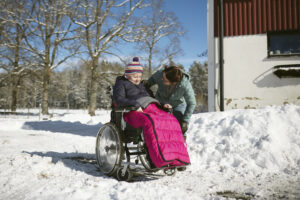Nurses are often described as the heart of healthcare, dedicating their lives to caring for others with compassion and empathy. However, this emotional investment can take its toll on even the most experienced and resilient nurses. As home healthcare becomes an increasingly popular option for patients, there is a growing demand for qualified and compassionate home health nurses. Yet, this line of work also brings unique challenges that can lead to compassion fatigue.
In this blog post, we will explore practical strategies for home nurses to combat compassion fatigue and find balance in providing care while taking care of themselves. Whether you’re a seasoned nurse considering transitioning into home healthcare or a new graduate looking to specialize in this field, these tips will help you maintain your passion while avoiding compassion fatigue.
What is compassion fatigue?
Compassion fatigue, sometimes referred to as vicarious traumatization or secondary trauma, impacts nurses who have cared for patients with complex and devastating illnesses and conditions. For some nurses, caring for these patients can lead them to absorb their patient’s trauma and, over time, become unable to empathize and connect with their patients. Compassion fatigue is a state of dysfunction comprised of physical, emotional, behavioral and spiritual exhaustion and a reduced ability to perform the necessary tasks of their jobs.
The Butler Center for Research reports that a 2019 compassion fatigue study found that approximately 86% of nurses had moderate to high levels of the condition. Although all nurses are at risk, those who work closely with high acuity and terminally ill patients have a higher chance of contracting the condition. This includes oncology, emergency, pediatric, and hospice units as well as home healthcare. The COVID-19 pandemic further exacerbated the situation as nurses nationwide had to balance caring for people amid a public health crisis with protecting their health and looking after their families.
Although commonly associated with burnout, compassion fatigue differs in a few ways. While burnout can lead nurses to dread going to work and depersonalize their patients, it doesn’t affect their ability to connect with people. Compassion fatigue impacts individuals’ ability to participate in all relationships, not just workplace relationships. Compassion fatigue can also set in quickly after witnessing a traumatic event or caring for someone with trauma, while burnout develops over time.
Signs and symptoms
Physical
Hawai’i Pacific University’s staff report that several common physical symptoms can signal compassion fatigue, including headaches, muscle aches and sleep, and heart and digestive problems. These symptoms are brought on by stress, emotional overload and trauma. Some nurses also experience difficulties with cognitive function, headaches, memory and appetite.
Research suggests that nurses who consume substances such as cigarettes, sleeping pills, and anti-anxiety drugs have a higher reported frequency of compassion fatigue. Experiencing the condition can lead to unhealthy coping methods such as substance abuse and self-harm.
Emotional and behavioral
One of the most serious emotional symptoms of compassion fatigue is a lack of empathy and a sense of detachment. It can lead to feelings of empathy, increased anxiety, lack of patience, withdrawal and reduced productivity. Compassion fatigue can also present as angry outbursts, mood swings and lack of interest in pleasurable activities.
Impacts of compassion fatigue on nursing care
Compassion fatigue affects more than nurses’ physical and emotional state. The Hahn School of Nursing and Health Science from the University of San Diego wrote that patients heal faster when nurses show empathy, kindness and compassion. Specifically, patients can experience an increased sense of calm, lowered blood pressure, reduced pain and shorter hospital stays. When patients feel respected, seen and heard by their nurse, they don’t have to stress as much and can focus on doing what they need to get better.
Five tips to combat compassion fatigue
Understandably, nurses dealing with compassion fatigue may struggle with receiving help. The Butler Center for Research reports, “In the healthcare system, admitting to struggling with compassion fatigue may be synonymous with admitting defeat. One study found that accepting or admitting vulnerability was seen by almost all respondents as a sign of weakness, and that admitting to compassion fatigue was overwhelmingly associated with shame.”
Luckily, there are several ways to combat compassion fatigue.
1. Practice self-regulation
Compassion fatigue can cause you to feel dysregulated and out of control. Practicing regulation exercises such as meditation, mindfulness and breathing exercises can help you find your center and focus on what is important to you. If you follow a religious or spiritual practice, consider incorporating more prayer or chants into your daily routine.
2. Build connections with your support system
Holding your emotions inside can exacerbate the symptoms of compassion fatigue. Check in regularly with trusted friends, family members and coworkers to process your experiences and discuss your emotional state. Close personal relationships can improve physical and mental health as well as your outlook on life.
3. Change your schedule so that it works for you
Adding in more time for your personal life and well-being can improve your quality of life and reduce the effect of compassion fatigue. For example, if working night shifts back-to-back is challenging, try to move to day shifts or skip days between night shifts so you have time to rest and rejuvenate.
4. Prioritize self-care
Make time to incorporate self-care into your routine. Consider getting a massage, taking an enjoyable exercise class or walking through nature. Self-care does not have to be expensive or take up hours of your time, but it is important to do activities that make you feel calm and connected. Taking care of yourself can also include self-esteem-building exercises such as repeating positive affirmations and celebrating your wins.
5. Find a position that works for you
If your current position doesn’t fulfill you, it may be time to move to a different employer or nursing field. For example, nurses who move from working in a facility to working in home healthcare benefit from having smaller caseloads, building close relationships with patients and more flexible schedules.
Resources
Compassion Fatigue Awareness project
The Compassion Fatigue Awareness Project’s mission is to promote an awareness and understanding of compassion fatigue and its effect on caregivers. It is committed to gathering, documenting, and disseminating useful information to impact caregivers’ lives positively.
The Compassion Fatigue Awareness Project offers resources, including reading lists, self-tests and local caregiver organizations.
TED Talks
Compassion Fatigue: What is it and do you have it?
This TED Talk by Juliette Watt explores how to recognize and treat compassion fatigue. She also shares her experience with the condition and its effects on her life.
How to Manage Compassion Fatigue in Caregiving
In this talk, Patricia Smith, the founder of the Compassion Fatigue Awareness Project, recommends wellness activities and authentic self-care measures to help caregivers manage and process complex emotions.
At Maxim Healthcare Services, we understand the unique challenges that come with being a home health nurse and offer nursing roles in locations across the country that prioritize work-life balance. If you’re ready to make a difference in your community while also taking care of yourself, we invite you to join our team of dedicated healthcare professionals.
*The views and opinions expressed in the TED Talks do not necessarily reflect the view of Maxim Healthcare Services. The presentations are for entertainment purposes and should not be used as a source of medical advice*




